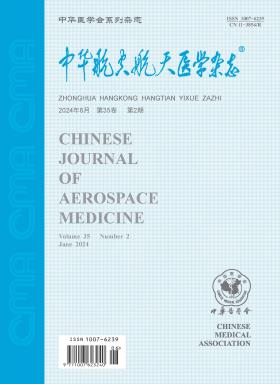Detection and reference value of cervical and ocular vestibular evoked myogenic potential in military pilots
引用次数: 0
Abstract
Objective To obtain the detection method and reference constants of cervical vestibular evoked myogenic potential (cVEMP) and ocular vestibular evoked myogenic potential (oVEMP) in military pilots and to provide reference basis for evaluating pilot's otolith function in aeromedical assessment. Methods Thirty-three (66 ears) healthy male active duty fighter pilots were selected as study subjects. They were between the age of 25 to 42 years old (30.3±4.8 years). cVEMP and oVEMP were induced unilaterally by means of 500 Hz air-conducted tone burst stimulation. The VEMPs threshold of each ear was examined and the reference range of amplitude, latency and wave interval were calculated. Results The composite wave of cVEMP and oVEMP was observed in 33 pilots. The evoked rate was 100%. The latency of p13 and n23, p13-n23 interval, peak-to-peak p13-n23 amplitude and asymmetry ratio of cVEMP in these pilots were (13.94±1.59)ms, (20.95±1.59)ms, (7.01±1.34)ms, (224.70±66.15)μV, (0.11±0.10). The amplitude had slight difference between the ears while the cVEMP p13 latency, n23 latency and wave interval showed very small difference between the ears. The latency of N1 and P1, N1-P1 interval, peak-to-peak N1-P1 amplitude and asymmetry ratio of oVEMP in the pilots was (11.1±0.99)ms, (15.41±0.85)ms, (4.31±0.84)ms, (2.23±0.59)μV, (0.10±0.08) respectively. The amplitude of oVEMP, latency of N1, latency and wave interval of P1 showed unobvious difference between left and right ears. Conclusions This study has established the conventional detection methods and constants of cVEMP and oVEMP of military pilots and these provide the objective reference to evaluate the functions of utricle and sacculus in aeromedical assessment. Key words: Vestibular function tests; Evoked potentials; Saccule and utricle; Pilot军事飞行员颈、眼前庭诱发肌电位检测及参考价值
目的探讨军事飞行员颈前庭诱发肌电位(cemp)和眼前庭诱发肌电位(oVEMP)的检测方法和参考常数,为航空医学评估中飞行员耳石功能的评价提供参考依据。方法选取健康男性现役战斗机飞行员33名(66耳)作为研究对象。年龄25 ~ 42岁(30.3±4.8岁)。cemp和oVEMP是通过500 Hz空气传导音脉冲刺激单侧诱导的。检测各耳VEMPs阈值,计算振幅、潜伏期和波间隔的参考范围。结果33名飞行员均观察到cemp与oVEMP的复合波。诱发率为100%。p13和n23潜伏期、p13-n23间隔、p13-n23峰间振幅和cemp不对称比分别为(13.94±1.59)ms、(20.95±1.59)ms、(7.01±1.34)ms、(224.70±66.15)μV、(0.11±0.10)。耳间cemp p13潜伏期、n23潜伏期和波间隔差异很小。飞行员的N1和P1潜伏期、N1-P1间隔、N1-P1峰间振幅和oVEMP不对称比分别为(11.1±0.99)ms、(15.41±0.85)ms、(4.31±0.84)ms、(2.23±0.59)μV、(0.10±0.08)μV。左、右耳oVEMP振幅、N1潜伏期、P1潜伏期和波间隔无明显差异。结论本研究建立了军用飞行员cemp和oVEMP的常规检测方法和常数,为航空医学评估中评价小囊和小囊的功能提供了客观参考。关键词:前庭功能测试;诱发电位;囊和胞室;飞行员
本文章由计算机程序翻译,如有差异,请以英文原文为准。
求助全文
约1分钟内获得全文
求助全文
来源期刊

中华航空航天医学杂志
航空航天医学
自引率
0.00%
发文量
2962
期刊介绍:
The aim of Chinese Journal of Aerospace Medicine is to combine theory and practice, improve and popularize, actively advocate a hundred flowers bloom and a hundred schools of thought contend, advocate seeking truth from facts, promote the development of the related disciplines of aerospace medicine and human efficiency, and promote the exchange and penetration of aerospace medicine and human efficiency with other biomedical and engineering specialties.
Topics of interest for Chinese Journal of Aerospace Medicine include:
-The content of the journal belongs to the discipline of special medicine and military medicine, with the characteristics of multidisciplinary synthesis and cross-penetration, and mainly reflected in the aerospace industry, aerospace flight safety and efficiency, as well as the synthesis of special medicine, preventive medicine, environmental medicine, psychology, etc.
-Military aeromedicine (Air Force, Navy and Army aeromedicine) and civil aeromedicine, with a balance of aerospace medicine are the strengths of the journal.
-The change in aerospace medicine from a focus on promoting physiological compensatory adaptations to enhancing human performance under extreme environmental conditions is what the journal is helping to promote.
-The expansion of manuscripts in high altitude medicine is also a special emphasis of the journal.
 求助内容:
求助内容: 应助结果提醒方式:
应助结果提醒方式:


